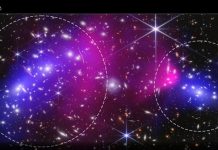
NASA’s Spitzer Space Telescope has provided astronomers with fascinating images that show how the supermassive black hole at the center of the Andromeda galaxy, one of our closest galactic neighbors, feeds on surrounding dust and gas.
These findings help explain why some enormous black holes in the universe can consume vast amounts of material yet remain surprisingly quiet.
Unlike more turbulent black holes, which light up the galaxy when devouring matter due to the intense heat generated, the black hole in Andromeda is a quiet eater.
Its light remains almost constant, suggesting it consumes a steady, controlled flow of dust and gas.
This gentle feeding process is similar to water swirling smoothly down a drain, without the violent fluctuations seen in other cosmic giants.
Researchers used computer simulations to study how gas and dust behave near Andromeda’s black hole.
They discovered that a small disk of hot gas forms near the black hole, continuously feeding it.
This disk is kept replenished by streams of gas and dust that must maintain a certain size and flow rate.
If these streams are too large or fast, they would clump together and fall unpredictably into the black hole, causing bursts of light.
The team compared their simulation results with actual data from Spitzer and the Hubble Space Telescope. They observed spirals of dust, previously identified by Spitzer, feeding into the black hole in a pattern that supports their simulations.
This correlation between the observed data and the simulations confirms the theory of steady feeding.
This study not only showcases the value of revisiting old data with new technology and theories but also enhances our understanding of how galaxies and their central black holes interact.
Almudena Prieto, an astrophysicist involved in the study, highlighted the importance of archival data, which continues to inform scientists about galaxy dynamics years after its collection.
Launched in 2003 and managed by NASA’s Jet Propulsion Laboratory, the Spitzer Space Telescope explored the universe in infrared light, invisible to human eyes.
This allowed astronomers to see different aspects of galaxies, including Andromeda. Spitzer’s images reveal the galaxy’s structure by separating various wavelengths to show stars, dust, and areas where new stars may form.
Interestingly, although Andromeda is a spiral galaxy like our Milky Way, it features a large dust ring at its center rather than distinct arms. Spitzer’s images also showed a gap in this ring, likely caused by a dwarf galaxy passing through.
Andromeda’s size and proximity to Earth make it appear six times wider than the moon when viewed with the naked eye.
Despite its vastness, capturing its full image required Spitzer to take 11,000 individual snapshots, illustrating the vast scale and detailed work involved in studying such a colossal neighbor.



